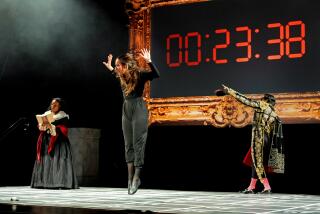At Season Finale, EAR Unit Salutes Dada
- Share via
Dada didn’t last long. It started in Zurich as an absurdist response to World War I, then flickered briefly after the war in Paris, Berlin and New York. But it cast its shadow, its mad celebration of the absurd, over our century.
That shadow still looms, and the California EAR Unit planted itself under it Wednesday night. For the final concert of its season at the Los Angeles County Museum of Art, it related historic Dada performance to our times, going so far as to commission a new piece from a former member of the Mothers of Invention, rock ‘n’ roll’s answer to Dada in the ‘60s.
Dada performance included revolutionary works by the likes of Kurt Schwitters, who created whole sonatas derived from the virtuosic recitations of syllables and phonemes. But Dadaists also had a penchant for silly costumes and lobbing tomatoes at the audience.
The EAR Unit eschewed the tomatoes, but one performer, Charles Lane, dressed as a rapper in ski cap and shades and reciting Schwitters “Doof,” did squirt a water pistol at the first rows of the Leo S. Bing Theater. Arthur Jarvinen and Gaylord Mowrey donned reproductions of Hugo Ball’s robotic costumes for “Gadji beri bimba,”a work astonishing in its rhythms and vocal sound effects. Lane also returned in foppish tails for a hilarious rendition of Schwitters’ “Niesscherzo” (Sneezing Scherzo).
Still, it is not easy to re-create Dada times without seeming quaint, and the EAR Unit’s solution was to employ the Dadaist principle of simultaneity, the attempt to mirror its visual collages with a theater of wildly unrelated actions performed simultaneously. So Schwitters shared the stage with an excerpt from John Cage’s indeterminate “Song Books,” which asks for theatrical actions and which Amy Knoles interpreted as rummaging through old shoes.
And Cage shared the stage with Annea Lockwood’s wonderfully Dadaesque 1974 piece, “Spirit-Catchers,” in which four women speaking extemporaneously about an important experience become one, thanks to a sound-mixer who continually moves the live microphone.
Three such circuses set the tone for three recent works. The most affecting was Eve Beglarian’s “Landscaping for Privacy,” in which the composer read a sexually frank but haunting poem by Linda Norton over an insinuating accompaniment of piano and percussion (and an occasional wind). Not much Dada here, but unrelated rhythms did underscore the poem’s sense of alienation that idyllic surroundings seem to invoke in urban New Yorkers.
The former Mother, Don Preston, was, however, far more tenuously Dadaist, despite the pretensions of his new piece, “Bride Stripped Bare.” He used as a percussion instrument a sheet of glass painted to resemble Marcel Duchamp’s famous large glass, “The Bride Stripped Bare by Her Bachelors, Even.” But otherwise Preston, who joined the EAR Unit as pianist for his piece, offered little more than the kind of rambles Frank Zappa was known for in his more serious instrumental pieces--a little jazz, a little funk, a few early 20th century classical gestures. Preston, however, was without the Zappa personality.
The final work was a new arrangement that Jarvinen made of “Songs of Drella,” a cycle of songs by former Velvet Underground members John Cale and Lou Reed in tribute to Andy Warhol. These turned out to be dutiful transcriptions from rock instrumentation to piano, electric keyboard, violin, cello and percussion, with Jarvinen doing a decent job of mimicking Reed’s singing voice.
The actual connection between Warhol, the Velvet Underground and Dada was more theory than practice, but the EAR Unit had a brilliant stroke at the end. It faded in an LP recording made in 1965 of Aram Saroyan reading his poem “crickets,” the poet repeating the word until its sound becomes the sound of crickets. Who knows why that should have seemed so terribly poignant? Dada is not the kind of thing that ever held up very well to explanation.
More to Read
The biggest entertainment stories
Get our big stories about Hollywood, film, television, music, arts, culture and more right in your inbox as soon as they publish.
You may occasionally receive promotional content from the Los Angeles Times.











